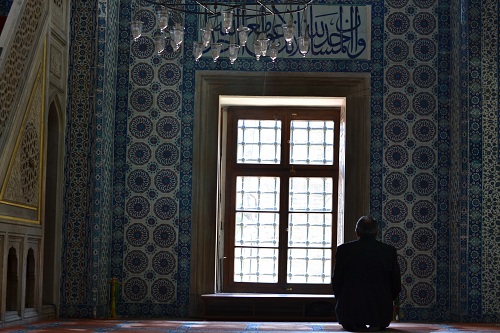When Kayan and Ava first heard the muslim call to prayer they were scared. “Too loud!” proclaimed Kayan. “Is that the police?” asked Ava. The first few nights in Turkey, they were shaken awake by the sunrise prayer call. They have since learned about the prayers and now slumber until late morning. I find the call to prayer soothing. It reminds me of my childhood in Egypt. The night call is like a childhood lullaby to me.
We’ve spent a lot of time in religious houses during our trip. There were the Taoist temples in Penang, the Buddhist monasteries in Thailand and pagodas in Myanmar, and the synagogue, churches and Hindu temples in India. We had not yet paid homage to Islam until reaching Turkey.
Our first stop was Aya Sophia, which was built in 360 A.D. as a basilica, converted to a mosque in 1453 and then a museum in 1935. The massive Byzantine structure is said to have changed the face of architecture and remained the world’s largest cathedral for a thousand years. Today, motifs of Christ and Mary stand alongside Muslim scripture.

We tried to visit the famous Blue Mosque, but our arrival coincided with a call to prayer. We spent time in the inner court yard where this scene of chatting women huddled against the ancient doors.

The crowds when we went back at the Blue Mosque were overwhelming, so we opted for the smaller and less tour visited Rustam Pasa, a 450+ year old mosque that has the country’s best preserved display of Iznik tile work. While we were there, a Muslim woman started playing with Ava and Kayan, even taking them around the mosque for a walk while we sat in peace.

Just down the road from our apartment is the Kilic Ali Pasa. We pass it almost every day and a welcoming guard always smiles at us. Today we stepped inside to see its beautiful interiors. A man who just finished his prayers asked where we were from and welcomed us to explore the mosque.

We knew that Istanbul’s mosques are drenched in history and architectural greatness. However, we were at first reticent about visiting mosques that were not visibly open to tourists. Here is some etiquette that may help make a mosque visit feel more natural.
– Like most houses of worship, anyone is welcome into a mosque. Entrance is usually free but a donation for the mosque upkeep is a nice gesture.
– Even though most mosques are continuously open, it’s best not to visit during prayer times or on Friday mornings, which is when sermons are held. I remember having tourists taking pictures during our wedding in Cochin. It was highly annoying.
– Attire etiquette is similar to Buddhist houses of worship. Everyone should remove their shoes and wear clothing that goes below knees and elbows. Women should also cover their heads (as in their hair, not their entire faces).
– Just as in church, speak softly. Or sing softly if you are a toddler.
– Photography is acceptable but it’s probably better to ask for permission before taking pictures of people.
The bottom line is that mosques, at least those we visited in Istanbul, are open houses of worship. Everywhere we went, people welcomed us, happy that we came to respectfully appreciate their heritage.

Best be respectful. One never knows which is the “One True Religion” – if there is one!
BTW lovely pix
We’re trying to make sure that what we consider respectful is not offensive 🙂 It’s odd – for all the time we spent in Egypt, I was intimidated about going into a mosque.